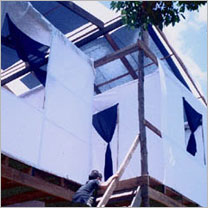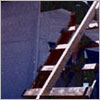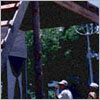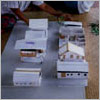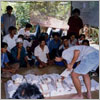|
Under-bridge Community Housing
Design Workshop and the Model House
Exhibition Diary Report by Patama Roonrakwit 14 February 1999 – 25 April 1999 14 Feb 1999 In the morning we introduced the people to how we could work together in the following five weeks. We handed out a questionnaire to start to find out general information about each family. Some people could neither read nor write so we helped them. We gave out paper, pencil and crayons and asked the people to draw their ‘dream houses’. During this time we marked out real size plots in a garden using bamboo poles and plastic rope to show the people. There were four sizes, 6x8, 5x10, 6x7, and 5x8 metres. After having lunch together, we talked a bit about the dream houses they had drawn. This lead to the next stage, which was to try and make the dream houses real. We gave out grid paper and furniture symbols to stick on. One grid equaled a square metre, this helped the people create their designs to scale, it was a fun stage. One lady said, “I don’t have any furniture, do I have to stick them on?” So we had to convince her, that her life was hopefully going to be better in the near future. Many people did not put any windows in their designs. This prompted us to ask the people if it would be too dark inside, they told us they would not be afraid of darkness because their existing houses did not have much light under the bridges. It was difficult to design a new house for someone who was used to living in such a place. We finished by asking the people to think of existing materials and others that they could find for free, to help build their houses. |
||||
Note : The people were very keen although there were some difficulties to design a house considering that the people had lived in such a place.
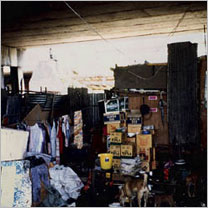 |
21 Feb 1999 We started by giving the people back the plans they had designed last Sunday and some cardboard to make a model house. Many new faces turned up; so we asked the newcomers to learn from the others that had came last week. One guy from zone 4 made a model between the workshops, we were so impressed. It was neatly made from lightwood. Another old lady from zone 2 also made a model in her time and it too was very beautiful. These models stimulated the rest of the group to make theirs. Today we had two Japanese friends from Cambodia to help us, Keke and Tomoko. We finished in the afternoon by placing all the models together on a site plan. The people were very proud, but in the same time felt a little strange of the community they had made in front of them. There was no space for trees, clothing lines or room for ventilation. The houses were so tightly packed together most windows were unable to be opened. A community member after looking at the model raised the issue of fire escape and soon a group conversation began about how the community layout could be improved. |
Note : After the workshop, we prepared tools for the next workshop. Using information from previous workshops we summarized the functions and the space the people wanted and calculated the average size of a bedroom to be 9m, a kitchen 4-6m, a bathroom 2-4 m and a living room 9m. We constructed boxes of these room dimensions. People started to be aware of other considerations beyond their individual houses and begun to agree on other design factors that would benefit the whole community.
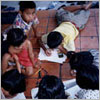 |
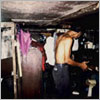 |
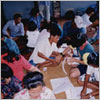 |
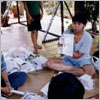 |
28 Feb 1999
Today we gave the people different box sizes ranging from 1x2, 2x2, 2x3 and 3x3 and reminded them of the lessons learnt from the previous week. The people made their houses by arranging the boxes. Some people worked together to construct semi-detached homes; others worked on their own. In this workshop people designed their house layouts with the consideration of the houses around their own. We sketched and took photographs of all the models so we could draft up the houses later at our office. After the workshop finished we gave out a materials schedule to fill in during the week so we could begin to estimate the cost of construction in the following week. We had asked the people to fill in the schedules with cheap and free materials with anything appropriate they could find.
Note : There were many new faces and this interrupted the workshop as the newcomers had no knowledge of the previous workshops and had developed nothing.
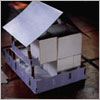 |
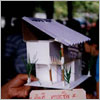 |
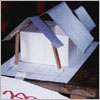 |
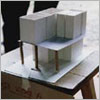 |
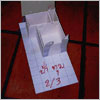 |
7 March 1999
Many people did not turn up. We stuck the scaled plans of the people’s houses onto boards. The people were excited, we asked them to check their designs. The majority was satisfied, but a few designs needed amending. We handed out a copy to everyone so as they could specify the materials they wanted to use and could begin to estimate a cost from their material schedules. In the afternoon we handed out 1:500 site plans. The people were divided into zones to design the public space around their houses. Only zone 4 designed a site plan. Note: There were a lot of discussions with no conflicts, very impressive.
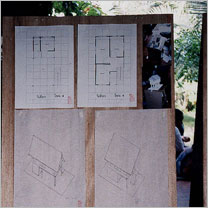 |
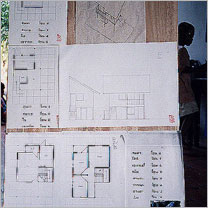 |
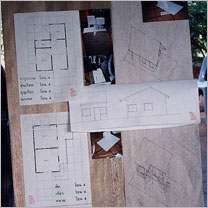 |
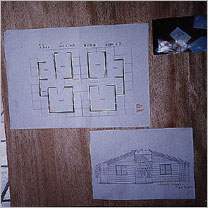 |
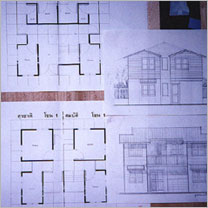 |
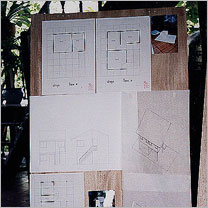 |
|
14 March 1999
We tried to finish cost estimating. We gave out the final design of their homes. Now everyone was satisfied. We presented zone 4’s site plan, drawn from the preliminary designs from the previous workshop. After lunch we talked about the materials that could be collected from the street and garbage. Many ideas were presented. We asked for volunteers to work on an exhibition for the following Sunday. We agreed to start preparing material samples next workshop. Many people promised to bring cans, bottles and oil containers
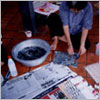 |
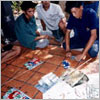 |
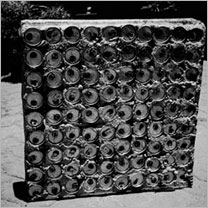 |
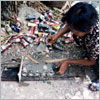 |
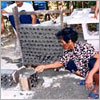 |
28 March 1999
There were ten people present, the people who had promised to bring materials did not come, so we used materials we already had. We cleaned bottles to use as bricks. Old ladies and children helped making panels from newspaper. We made an appointment for next week and asked the people to bring more materials.
1 April 1999
We visited Klong Tuey to look at timber. We gave the community a plan of our requirements. They promised to tell us what they could provide on April 9th, give us time to buy the remainder.
2 April 1999
The people went to meet the deputy governor of Bangkok to finialise the location and arrange equipment to be provided for the exhibition.
16 April 1999
We had not received any news from Klong Tuey. We continued sewing the cloth to be used for cladding the model houses.
20 April 1999
We received 20 pieces of timber size 1.5”x3”x2m, we decided to buy the rest. Sert (one of the community members) offered some of his timber he had collected for his new house.
21 April 1999
We started to build the first house frame, a one-storey house, with help from builders from Klong Tuey and the people. We were able to assemble and dismantle the frame in the afternoon in preparation for the exibition on the 23 April.
22-23 April 1999
An afternoon of cutting, gluing, colouring, typing and printing, we prepared presentation boards and cutouts for the exhibition.
24 April 1999
The people finished installing the first model on Friday, unfortunately in the wrong place, so we moved it to its right place, following this hiccup we started to build the two storey houses. The people helped covering the first one with the cloth we had prepared. The second house was finished in late afternoon but still remained to be covered with cloth. The third house was finished after midnight. So bad, a man who was helping to build the house, fell down from the roof, we took him to hospital. We finally completed the three houses just before dawn.
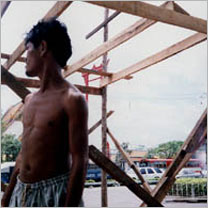 |
 |
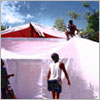 |
 |
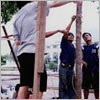 |
 |
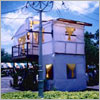 |
25 April 1999
“Baan Mai Tai Sa-Paan” model house exhibition day.
